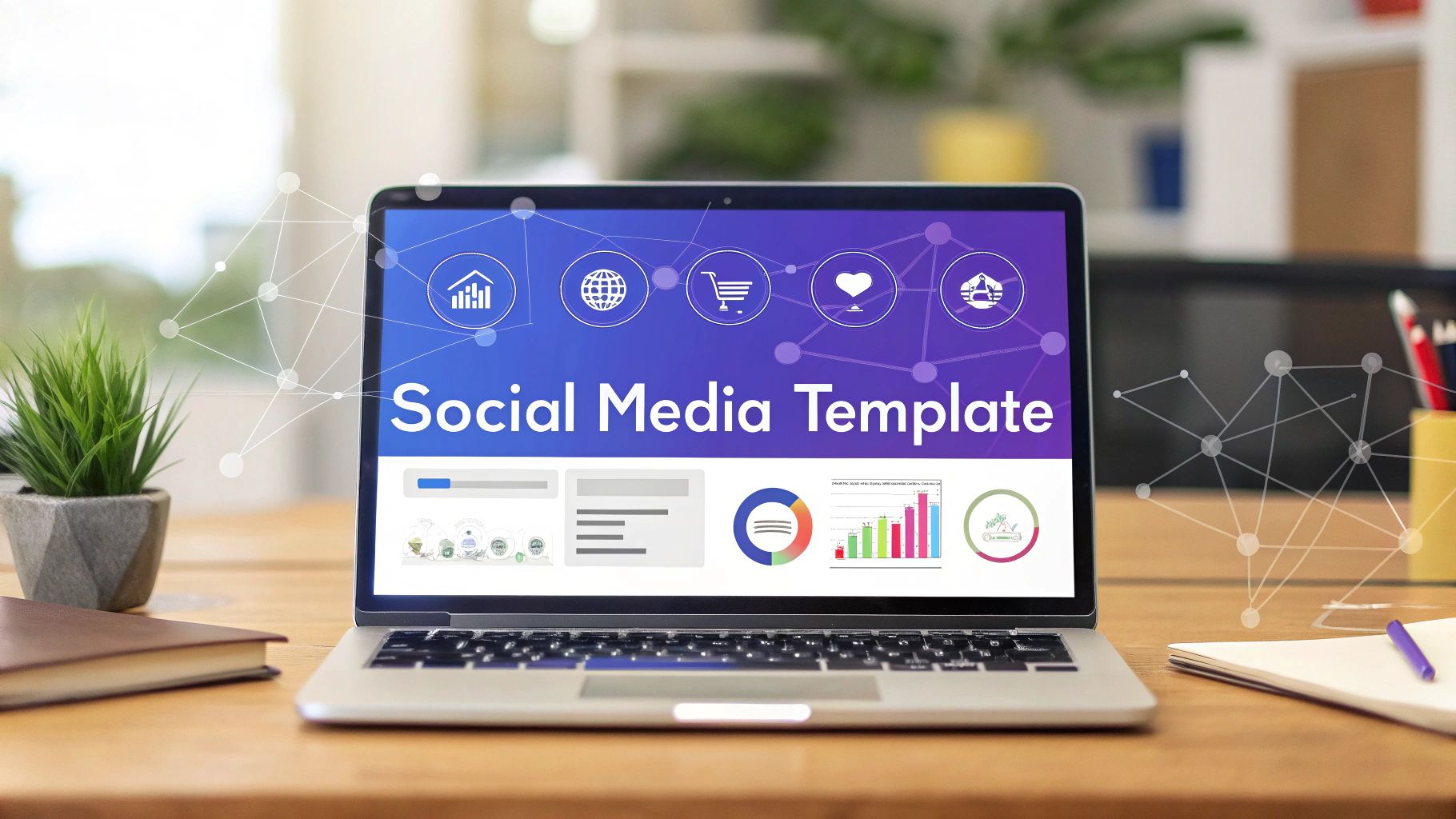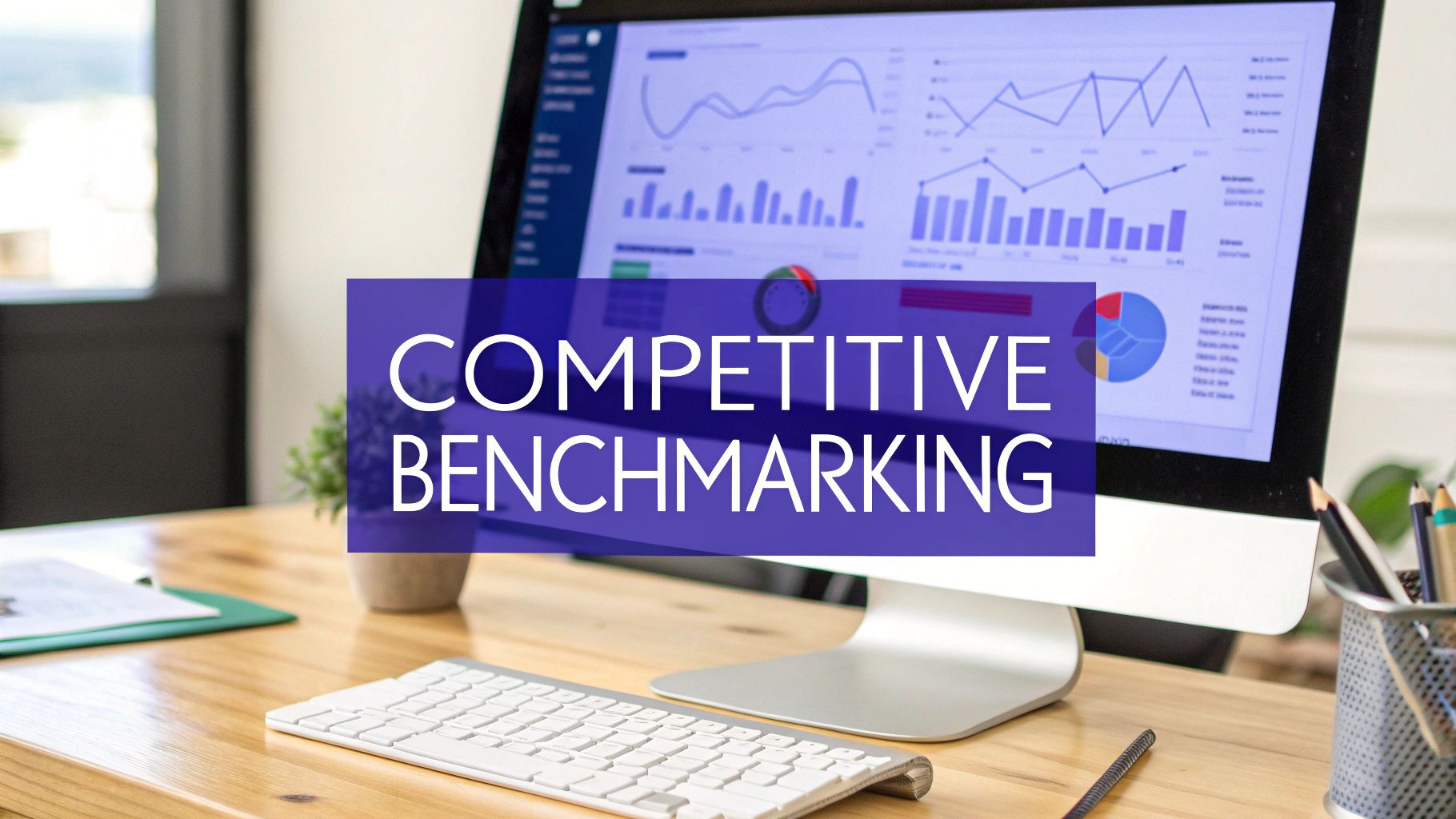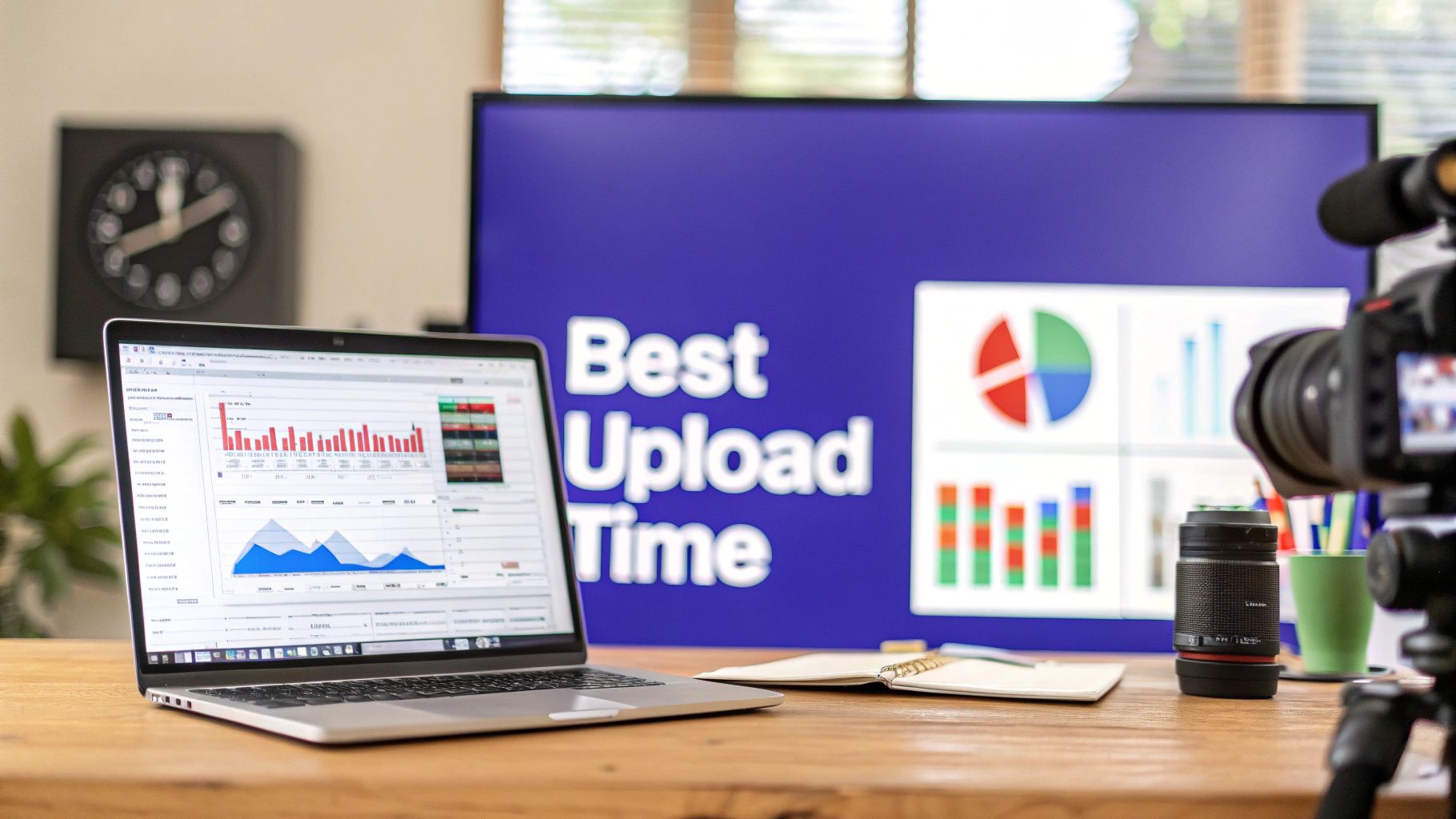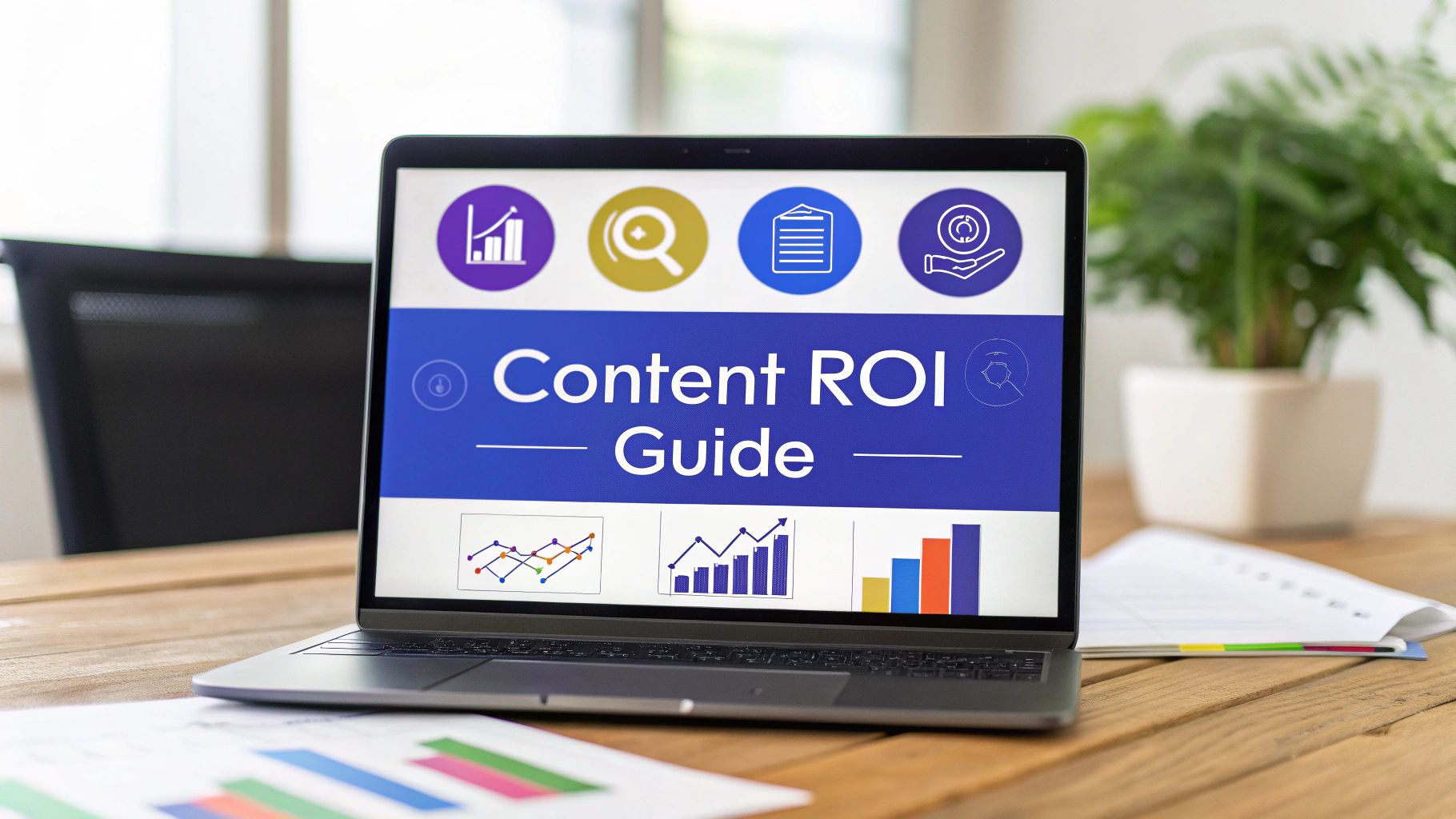A social media marketing strategy template is much more than just a content calendar. Think of it as your strategic playbook—a living document that connects every single tweet, story, and post back to your bigger business goals. It's what ensures your efforts aren't just busywork but are actually driving real, measurable results.
Laying the Groundwork for Your Strategy
Before you even dream about the perfect Reel or viral TikTok, you have to pour the foundation. A winning social media presence is built on two things: crystal-clear objectives and an honest assessment of where you stand right now. This is where you stop chasing vanity metrics like follower counts and start focusing on what actually moves the needle for your business.
The first practical step is to conduct a full-scale social media audit. And I don't mean a quick five-minute scroll through your feeds. This is a deep dive. You need to get into the weeds of your existing accounts to see what's connecting, what's flopping, and where the hidden gems are. Are your Instagram stories getting way more engagement than your static feed posts? Is LinkedIn actually bringing in better leads than Facebook? Answering these kinds of questions gives you a solid baseline to build from.
Sizing Up the Competition
Once you have a handle on your own performance, it's time to look over the fence. A competitive analysis isn't about copying what everyone else is doing; it's about spotting the gaps. See what your rivals are nailing, but more importantly, look for what they're missing.
Maybe they're killing it on Instagram but have zero presence on TikTok, even though you know a chunk of your target audience lives there. That's your opening.
By finding those underserved platforms or content styles, you can carve out a unique space for your brand to own. The goal is to learn from your competitors, not just imitate them.
This whole process—from setting goals to analyzing the competition—is really a logical flow. Each piece informs the next, as you can see here:
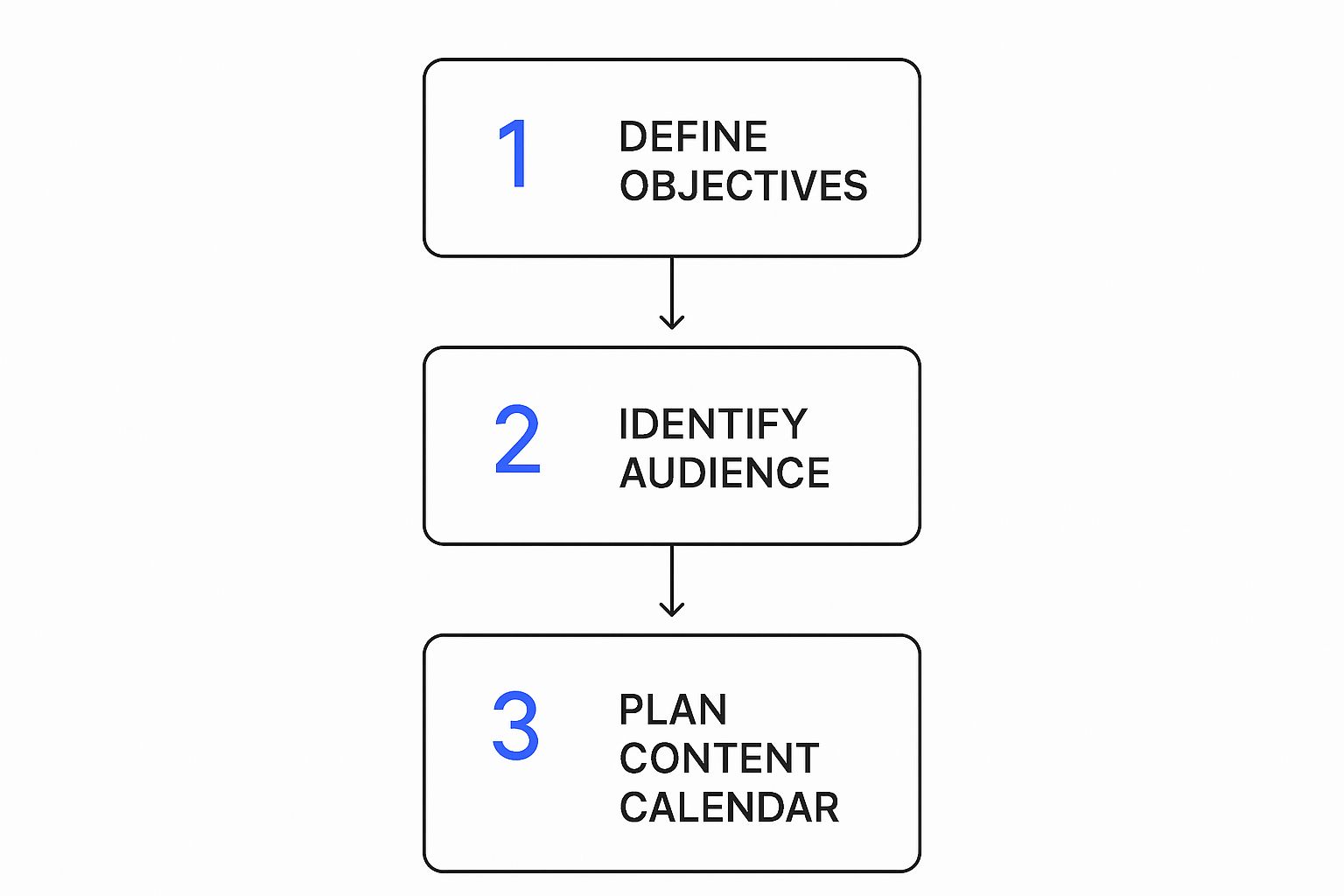
This simple flow shows how a coherent strategy is built from the ground up, with each step logically building on the last. To bring this all together, using a proven social media marketing plan template can provide the structure you need. You can also dig deeper with our detailed guide on creating a complete social media marketing plan template for even more insights.
Breaking Down the Core Components
To make this even more tangible, every solid strategy template needs to have a few core pillars. Think of this table as your checklist for building a plan that covers all the essential bases.
Core Components of Your Strategy Template
| Strategy Component | Key Action | Purpose |
|---|---|---|
| Business Objectives | Define 1-3 primary business goals (e.g., increase leads by 15%). | Ensures every social media action is tied to a tangible business outcome. |
| Audience Personas | Create detailed profiles of your ideal customers. | Helps you craft content that resonates deeply with the right people. |
| Competitive Analysis | Identify 3-5 main competitors and analyze their social presence. | Finds gaps in the market and opportunities for your brand to stand out. |
| Platform Selection | Choose the social media channels where your audience is most active. | Focuses your resources on the platforms that will deliver the best ROI. |
| Content Pillars | Establish 3-5 core themes your content will revolve around. | Creates a consistent brand voice and makes content creation more efficient. |
| Key Metrics (KPIs) | Select the specific metrics you will track (e.g., engagement rate, CTR). | Allows you to measure success objectively and make data-driven decisions. |
This framework isn't just about filling in boxes; it's about forcing you to think strategically about every aspect of your social media presence, turning vague ideas into a concrete, actionable plan.
Finding Your Audience and Best Platforms

One of the most common mistakes I see in social media is the "spray and pray" approach—trying to be everywhere at once. An effective social media marketing strategy template isn't about blanketing every platform; it's about being strategic. You have to show up where it matters most, which is where your audience actually spends their time. Spreading your team and budget too thin is just a fast track to burnout and mediocre results.
The key to smart platform selection starts with a deep, almost obsessive understanding of your audience. This goes way beyond basic demographics. You need to build out detailed audience personas, which are essentially semi-fictional profiles of your ideal customers. These shouldn't be dry data points; they should feel like real people with motivations, frustrations, and specific online habits.
Crafting Meaningful Audience Personas
To build a persona that actually works, you have to dig past the surface-level stuff like age and location. The real gold is in the "why." What problems are they desperately trying to solve? What kind of content makes them stop their endless scrolling and pay attention?
Let’s imagine we're building a persona for a B2B software company. We could create "Marketing Manager Molly."
- Her Role: She's a Marketing Manager at a mid-sized tech company, probably juggling a dozen things at once.
- Her Pain Points: She constantly struggles to prove ROI for her campaigns and is trying to manage a small team with not enough time in the day.
- Her Goals: She's on the hunt for tools that can save her team time and give her clear, actionable analytics she can show her boss.
- Her Online Habits: You'll find her on LinkedIn during work hours, looking for professional development content. But in the evenings, she’s scrolling Instagram for a mix of inspiration and entertainment.
See how that detail immediately gives you direction? You now know that LinkedIn is your primary channel to reach Molly with educational, problem-solving content. Instagram, on the other hand, could be a great secondary channel for more relaxed, brand-focused content.
A great persona is a strategic tool, not just a profile. It should directly inform every content decision you make, ensuring you’re speaking to a specific person, not a faceless crowd.
Matching Your Brand to the Right Platforms
Once you know exactly who you're talking to, you can figure out where to have the conversation. Every social platform has its own distinct culture, user base, and content style. Your job is to find the sweet spot—the overlap between where your audience hangs out and which platforms align with your brand's voice and strengths.
It’s just common sense, really. A highly visual brand, like a boutique hotel or a hip restaurant, is going to kill it on platforms like Instagram and Pinterest. Their entire business is built on aesthetics, and those channels are designed for gorgeous, visual storytelling. On the flip side, a law firm would get far more traction by establishing itself as a thought leader on LinkedIn, where the audience is actively seeking professional expertise.
It all comes down to strategic alignment. A B2C e-commerce brand, for example, might create a tiered strategy like this:
- Primary Platform: Instagram. It's visual, has built-in shopping features, and a powerful influencer community. This is where the main effort goes.
- Secondary Platform: TikTok. Perfect for reaching a younger audience with fun, trend-driven short-form videos.
- Tertiary Platform: Facebook. Ideal for running highly targeted ad campaigns and building a community with Facebook Groups.
This tiered system keeps you focused. You pour most of your energy into the channel with the highest potential ROI while still maintaining a strategic presence on other relevant platforms. The goal isn't to be scattered; it's to have a footprint that feels custom-fit for each community, making your social media marketing strategy template both focused and incredibly effective.
Developing Your Content and Engagement Plan
Okay, so you've mapped out your audience and picked your platforms. Now for the fun part—the actual content. This is the heart of your social media strategy, the stuff that stops the scroll, gets people talking, and ultimately turns casual followers into die-hard fans. Without a solid plan here, you're just posting into the void.
The bedrock of any great content plan is your content pillars. Think of these as three to five core themes your brand will own. They give you focus and keep your messaging consistent. For a fitness apparel brand, for instance, your pillars might be Workout Motivation, Healthy Recipes, and Product Technology. Simple, right? But they’re broad enough to spark endless ideas while still defining who you are.
Crafting a Content Mix That Actually Works
Nobody wants to see the same type of post over and over. A repetitive feed is a boring feed, and boring gets you unfollowed. You need a diverse mix of content to keep things fresh and appeal to different follower moods.
A balanced approach that I’ve seen work time and time again includes:
- Educational Content: This is your value-add. Think how-to guides, quick tutorials, or informative carousels that genuinely teach your audience something useful.
- Entertaining Content: Let your brand’s personality shine! Post behind-the-scenes moments, fun employee spotlights, or even hop on a relevant (and tasteful) trend.
- Community-Building Content: Make your followers the heroes. Run user-generated content (UGC) campaigns, ask engaging questions, or use polls to make them feel like part of the conversation.
- Promotional Content: Yes, you need to sell. But do it smartly. Highlight products in action, share glowing testimonials, or run special offers that feel exclusive, not pushy.
A great rule of thumb is the 80/20 rule: 80% of your content should provide value (educating, entertaining, or connecting), leaving just 20% for direct promotion. Once you've got this down, mastering proven social media content planning strategies is the natural next step to executing flawlessly.
Don't Forget: It's a Mobile and Video World
Always remember where people are seeing your content: on their phones. Social media is an overwhelmingly mobile experience. Projections show that by 2030, a staggering 83% of all social media ad spend will be on mobile.
On top of that, short-form video reigns supreme. Did you know that 78% of people would rather watch a short video to learn about a product? The data is clear.
Your content isn't just being viewed on a phone; it needs to be designed for a phone. This means vertical videos, bold and easy-to-read text overlays, and captions that are concise and impactful.
Your Proactive Plan for Engagement
Hitting "publish" is only half the battle. A truly effective social media plan includes a proactive strategy for engagement. This isn't just about passively replying to comments; it’s about actively starting conversations and building real relationships.
Your engagement plan should clearly outline:
- Response Guidelines: How will your team handle glowing comments, tough feedback, and customer service questions? Having a plan prevents panic.
- Proactive Outreach: Block out time every single day to engage with posts from your followers, jump into relevant hashtag discussions, and connect with influencers in your space.
- Community Management: Create a space where people feel welcome. Acknowledge your followers, feature their content (with permission!), and make them feel seen.
This kind of two-way communication is what builds deep-seated trust. It transforms your social media account from a simple broadcast channel into a buzzing community hub.
All these moving parts—from content pillars to engagement tactics—need a home. We've put together a guide on how to create a social media calendar that will help you pull it all together into one organized, manageable workflow.
Blending Human Connection and AI for a Smarter Strategy

If you really want to get an edge, your social media marketing strategy template needs to do more than just plan posts. It needs to weave together two of the most powerful forces in marketing today: authentic human connection and smart technology. That’s where influencers and artificial intelligence (AI) come in. When used together, they can seriously boost your impact.
Let’s be clear: influencer marketing isn't just about paying for a quick shout-out anymore. The real magic happens when you find partners whose audience and values genuinely click with your brand. Think of them as brand advocates, not just billboards. When a collaboration feels natural, it builds trust and leads to real engagement and sales.
This isn't just a hunch; the data backs it up. A recent study found that 59% of marketers are planning to increase their influencer collaborations. Why the rush? Because 76% of users admit that social content has swayed their purchasing decisions. For Gen Z, that number is a staggering 90%. It’s clear that authentic partnerships are no longer a "nice-to-have" for modern brands.
Finding Influencers Who Are the Real Deal
Vetting potential influencers is probably the most crucial part of the process. It's so easy to get distracted by follower counts, but you need to dig deeper. Focus on engagement metrics and what their audience is actually saying. Honestly, a micro-influencer with 10,000 super-engaged followers in your niche is almost always more valuable than a macro-influencer with a million silent ones.
Here’s a quick checklist for your vetting process:
- Audience Alignment: Do their followers look like your ideal customers? Dive into their analytics to check demographics and interests.
- Content Quality: Does their content’s style and tone feel like your brand? You're looking for creativity and a professional touch.
- Real Engagement: Are the comments genuine conversations, or is it just a wall of "Great post!" from bots? Real interaction is the sign of a healthy, valuable community.
The goal should always be to build long-term relationships, not one-off transactional campaigns. When an influencer genuinely loves and uses your product, their content is infinitely more believable and compelling. That's what drives results.
Putting AI to Work (Beyond Just Writing Captions)
On the tech side of things, AI is here to make your strategy smarter, not just faster. While it's great for brainstorming a few content ideas or drafting captions, its real strength lies in data analysis and optimization.
Think bigger. AI tools can chew through massive amounts of performance data to spot trends you'd miss, optimize your ad spend down to the penny for maximum ROI, and even help you personalize user interactions at a scale that's impossible for a human team.
To really get the most out of AI, you need to learn how to talk to it. It’s a skill. If you want to get better at it, this guide on how to write AI prompts for better results is a great place to start. By blending human-led influencer marketing with AI-powered insights, your strategy becomes both more relatable and more intelligent.
Measuring What Matters and Optimizing

Let's be real: a strategy without measurement is just a guess. Your social media marketing strategy template is only as good as your ability to track what’s working and what isn't. This is where you prove your ROI and turn a static plan into a living, breathing growth engine.
One of the biggest mistakes I see brands make is getting obsessed with vanity metrics. Sure, a high follower count or a wave of likes feels great, but they don't directly pay the bills. True success is found in the Key Performance Indicators (KPIs) that connect squarely back to your business goals.
Shifting Focus to Actionable KPIs
Instead of just celebrating follower growth, we need to start measuring what truly moves the needle. Are people actually clicking the links in your posts? Are they signing up for your newsletter or downloading your e-book? Are they making a purchase? These are the questions that define success.
For most businesses, the most impactful KPIs fall into these buckets:
- Reach & Impressions: Think of this as your brand awareness pulse check. It tells you how many unique people saw your content and the total number of times it was viewed.
- Engagement Rate: This is the percentage of your audience that bothered to interact (like, comment, share). It's a direct signal that your content is actually resonating.
- Click-Through Rate (CTR): A crucial metric showing the percentage of viewers who clicked a link in your post. This is your gateway to driving traffic off-platform.
- Conversion Rate: The ultimate bottom-line metric. This tracks the percentage of users who took a desired action after clicking, like buying a product or booking a demo.
A recent Hootsuite survey really drives this home, revealing that 69% of marketers now prioritize metrics like conversion rates and CTR to demonstrate ROI. The industry is finally moving past the simple popularity contest of likes and shares.
This shift proves a growing understanding that social media efforts must be tied to tangible business outcomes.
Setting Up Your Tracking Systems
You don't need a massive, expensive tech stack to get started. Honestly, the native analytics tools inside platforms like Facebook, Instagram, and LinkedIn offer a treasure trove of data. They give you detailed insights into audience demographics, post performance, and engagement trends right out of the box.
When you're ready to get more efficient, third-party tools like PostSyncer can pull all your data into a single dashboard. This is a game-changer for comparing performance across different channels without constantly switching between tabs. It saves a ton of time and gives you a much clearer, big-picture view.
For a deeper look at this process, check out our complete guide on how to measure social media success. It provides a full framework for setting up your tracking and reporting.
The Cycle of Analysis and Adjustment
Your work isn’t done once the tracking is in place—far from it. The final, and arguably most important, step is creating a consistent rhythm for performance reviews. Whether it’s weekly or bi-weekly, it just needs to happen regularly.
During these check-ins, you should be asking some tough questions:
- What content format drove the highest engagement last week?
- Which platform is sending us the most qualified leads this month?
- What’s the general sentiment around our brand right now?
- Where are people dropping off in our conversion funnel?
The answers to these questions are pure gold. They tell you exactly where to pivot. If video carousels on LinkedIn are crushing it, double down. If your TikToks are falling flat, it's time to test a new creative angle or even question if your audience is really there.
This continuous loop of measuring, analyzing, and optimizing is what separates the brands that thrive from the ones that just post and hope for the best.
Your Social Media Strategy Questions Answered
Even with the best template in hand, putting a strategy into action always brings up questions. It's just part of the process. I've been there, and I’ve seen what trips people up the most.
Think of this section as your quick-reference guide. We’ve pulled together the most common questions marketers have when they move from planning to doing, with straight-to-the-point answers to help you sharpen your approach.
How Often Should I Actually Post on Social Media?
I get this one all the time. Everyone's looking for that "magic number" for posting, but the honest answer is: it doesn't exist. The right frequency is all about the platform's culture and your specific audience’s habits.
For example, a platform like X (what we all still call Twitter) moves at lightning speed. To stay relevant, you might need to post multiple times a day. The same goes for Instagram Stories. On the other hand, channels like LinkedIn or Facebook are different. Here, quality trumps quantity every time. You’ll likely see much better results with three to five high-quality, meaningful posts per week.
My advice? Start with these best practices, but treat your analytics as your ultimate source of truth. If you ramp up your posting and see engagement suddenly drop, you’ve hit your ceiling. Pull back, adjust, and let the data guide you to that sweet spot.
What’s the Real Difference Between Goals and KPIs?
It's so easy to get these terms tangled, but getting the hierarchy right is what separates a decent strategy from a great one. A solid social media marketing strategy template depends on this clarity.
Here’s a simple way I like to think about it, using a road trip analogy:
- Goal: This is your final destination—the big-picture business outcome you're driving toward. For instance, your goal might be to Increase Brand Awareness. It's broad and directional.
- Objective: This is a specific, measurable stop on your journey that proves you're making progress. It directly supports your goal. An objective could be to Grow our Instagram followers by 20% in Q3.
- KPIs (Key Performance Indicators): These are the gauges on your car's dashboard. You glance at them constantly to make sure you're on track. To measure the objective above, you'd track KPIs like your follower growth rate, post reach, and total impressions.
A goal gives you direction, an objective gives you a target, and KPIs tell you if you're actually getting closer to hitting it. Each one nests logically within the other.
How Much Budget Should I Set Aside for Social Media?
Budgeting for social is a classic "it depends" situation. It can vary wildly based on your industry, company size, and how ambitious your goals are. There's no single correct answer.
However, a common and sensible starting point for many businesses is to allocate between 5% and 15% of your total marketing budget to social media. This should cover everything from content creation to paid ads.
The key is to start small and be smart about it. Run a few test campaigns with a modest budget to see what kind of content resonates and which platforms give you the best bang for your buck. Once you have data showing what works, you can confidently make the case to scale up your spending. This is where your strategy template becomes invaluable—it’s the perfect tool for justifying that budget by clearly tying every dollar back to a measurable business objective.
Ready to stop guessing and start strategizing? PostSyncer provides all the tools you need—from AI-powered scheduling to comprehensive analytics—to build, execute, and measure a winning social media plan. Start your free 7-day trial and see the difference a smarter workflow can make. https://postsyncer.com
